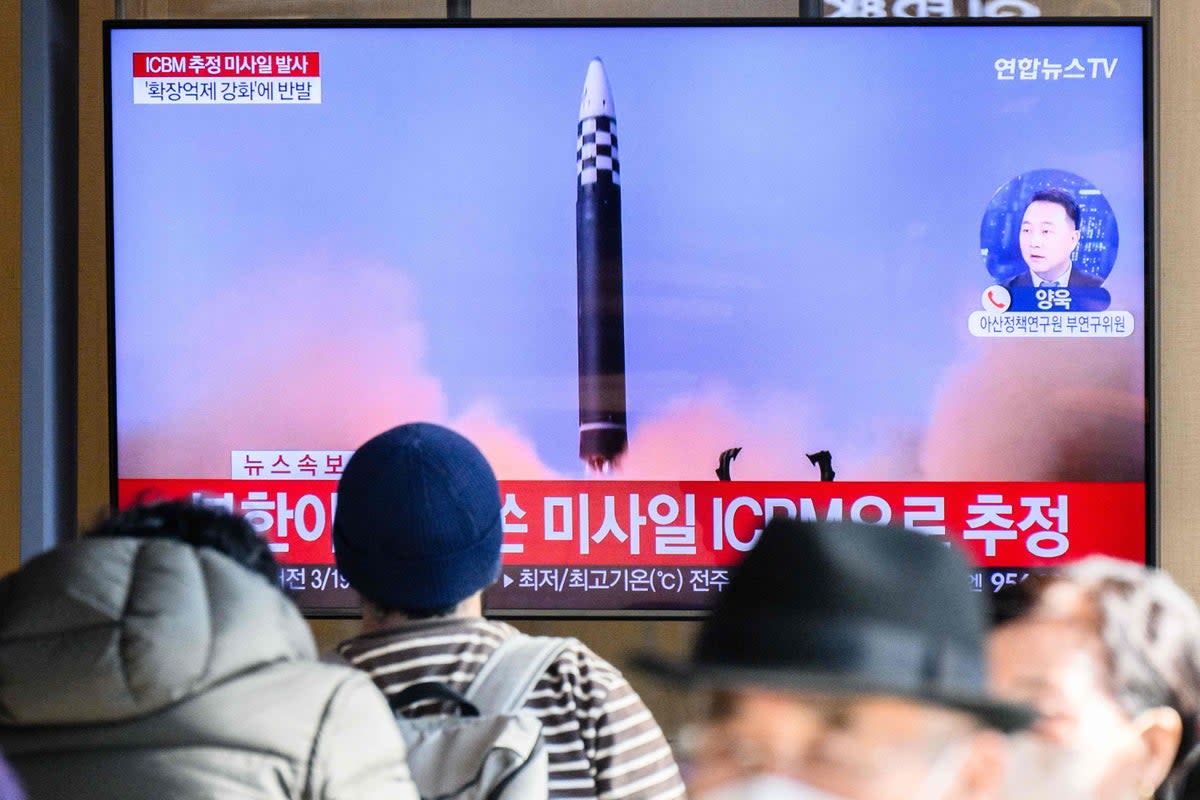North Korea launches biggest ever ICBM with ‘potential to strike entire US mainland’

- Oops!Something went wrong.Please try again later.
North Korea has launched an intercontinental ballistic missile that has the potential to strike the entire US mainland, the Japanese defence minister said on Friday.
The ICBM flew around 1,000 km before it landed in Japan’s exclusive economic zone, reaching a maximum altitude of around 6,100km, the South Korean military said.
It was North Korea’s second suspected test of banned long-range missiles this month, and its eighth launch this year.
The ICBM was fired from North Korea’s Sunan area in the capital Pyongyang at 10.15am local time (02.15am GMT), military chiefs in South Korea said.
Japanese defence minister Yasukazu Hamada said depending on the weight of a warhead to be placed on the missile, the weapon has a range exceeding 15,000km (9,320 miles), “in which case it could cover the entire mainland United States.”
He described a similar missile trajectory to that observed by the South Korean military, adding that the altitude achieved suggests the missile was launched at a high angle.
Japan’s prime minister, Fumio Kishida, condemned the test and said the missile appeared to have landed 200km west of the Japanese island of Hokkaido, inside its exclusive economic zone.
He said there had been no reports of damage to ships or aircraft.
“We naturally lodged a strong protest against North Korea, which has repeated its provocations with unprecedented frequency,” Mr Kishida told reporters in Thailand.
“We have told [Pyongyang] that we absolutely cannot tolerate such actions.”
The launch is suspected to be of the new Hwasong-17, North Korea’s longest-range two-stage ICBM, according to South Korean defence sources, reported Yonhap.
Its trajectory was similar to North Korea’s claimed test of a Hwasong-17 on 22 March. That projectile flew for 67.5 minutes to a maximum altitude of 6,248.5 km (3,905 miles), according to North Korean media.
South Korean president Yoon Suk-yeol condemned the launch, saying he would work with the international community for a coordinated response to the North‘s repeated missile launches.
It came as US vice president Kamala Harris was in Thailand for the Asia Pacific Economic Cooperation (APEC) summit amid heightened geopolitical tensions over the war in Ukraine and flashpoints in Asia, including Taiwan and North Korea.
It was Pyongyang’s second test in two days at a time when there are concerns North Korea could also carry out a major nuclear weapons test.
On Thursday, the hermit kingdom fired a short-range ballistic missile from the eastern coastal Wonsan area in KangwÅn Province, breaking an eight-day lull in tests.
That came after North Korea’s foreign minister Choe Son Hui warned of a “fiercer” military response to the US for its joint drills with South Korea and a renewed security commitment to allies in Seoul and Japan.
It was also Pyongyang’s first response to US president Joe Biden’s trilateral summit with Japanese and South Korean leaders in Cambodia on the sidelines of the Asean (Association of Southeast Asian Nations) summit.
Leif-Eric Easley, a professor at Ewha University in Seoul, says more governments should collectively hold North Korea accountable because its pariah state behaviour is not just a problem for Washington and its allies but a growing global threat.
“Pyongyang is trying to disrupt international cooperation against it by escalating military tensions and suggesting it has the capability of holding American cities at risk of nuclear attack.”
North Korea’s ballistic missile tests are banned by United Nations Security Council resolutions.
On 3 November, North Korea launched an ICBM which failed mid-flight at high altitude, South Korea said. Analysts said the launch appeared to also be of the Hwasong-17, but it failed to fulfil its completed flight trajectory and fell into the ocean at the separation stage.
North Korea has been actively testing two other types of ICBM – Hwasong-14 and Hwasong-15 – and their launches in 2017 proved they could potentially reach parts of the US homeland.

